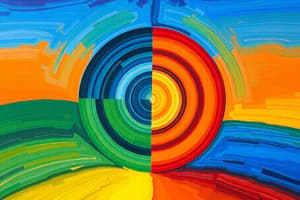Podcast
Questions and Answers
What causes seasons?
What causes seasons?
The tilt of Earth's axis causes seasons.
What is revolution in the context of Earth?
What is revolution in the context of Earth?
Earth's yearlong orbit around the sun.
Earth's orbit is an ________________________________________________.
Earth's orbit is an ________________________________________________.
ellipse, an elongated close curve.
When is Earth closest to the sun?
When is Earth closest to the sun?
When is the Earth farthest away from the sun?
When is the Earth farthest away from the sun?
Does the hemisphere that is tilted toward the sun receive more hours of sunlight than the hemisphere that is tilted away?
Does the hemisphere that is tilted toward the sun receive more hours of sunlight than the hemisphere that is tilted away?
Earth's tilts also causes the sun's ______________ to strike at different ____________.
Earth's tilts also causes the sun's ______________ to strike at different ____________.
What is a solstice?
What is a solstice?
When does the summer solstice occur in the northern hemisphere?
When does the summer solstice occur in the northern hemisphere?
When does the winter solstice occur?
When does the winter solstice occur?
How many equinoxes are in a year?
How many equinoxes are in a year?
What occurs on the spring equinox?
What occurs on the spring equinox?
When does the fall equinox occur?
When does the fall equinox occur?
What happens on June Solstice?
What happens on June Solstice?
What is the significance of the September equinox?
What is the significance of the September equinox?
What is the December Solstice?
What is the December Solstice?
What is the vernal or March equinox?
What is the vernal or March equinox?
Flashcards
Earth's Axial Tilt and Seasons
Earth's Axial Tilt and Seasons
The Earth's tilted axis is responsible for the changing seasons.
Earth's Revolution
Earth's Revolution
The Earth's yearly journey around the Sun.
Earth's Elliptical Orbit
Earth's Elliptical Orbit
Earth's path around the Sun is not a perfect circle, but an elongated oval shape.
Hemisphere Tilted Towards the Sun
Hemisphere Tilted Towards the Sun
Signup and view all the flashcards
Solar Radiation Angle
Solar Radiation Angle
Signup and view all the flashcards
Solstice
Solstice
Signup and view all the flashcards
Summer Solstice (Northern Hemisphere)
Summer Solstice (Northern Hemisphere)
Signup and view all the flashcards
Winter Solstice (Northern Hemisphere)
Winter Solstice (Northern Hemisphere)
Signup and view all the flashcards
Equinox
Equinox
Signup and view all the flashcards
Spring Equinox
Spring Equinox
Signup and view all the flashcards
Fall Equinox
Fall Equinox
Signup and view all the flashcards
June Solstice Details
June Solstice Details
Signup and view all the flashcards
September Equinox Details
September Equinox Details
Signup and view all the flashcards
December Solstice Details
December Solstice Details
Signup and view all the flashcards
Vernal Equinox Details
Vernal Equinox Details
Signup and view all the flashcards
Study Notes
Seasons and Their Causes
- Earth’s axial tilt is responsible for the changing seasons.
- Revolution refers to Earth's yearlong orbit around the Sun.
- Earth's orbit is elliptical, meaning it is an elongated close curve.
Proximity to the Sun
- Earth is closest to the Sun in January.
- Earth is farthest from the Sun in July.
Sunlight Distribution
- The hemisphere tilted toward the Sun receives more hours of sunlight compared to the opposing hemisphere.
- The tilt also affects how solar radiation strikes different angles on Earth.
Solstices and Equinoxes
- A solstice is the day when the Sun reaches its maximum distance north or south of the equator.
- Summer solstice in the Northern Hemisphere occurs around June 21 or 22, marking the longest hours of daylight.
- Winter solstice occurs around December 21 or 22, indicating the least amount of sunlight received.
Equinox Definition
- An equinox occurs when the Sun is directly above Earth’s equator, leading to equal day and night lengths.
- There are two equinoxes each year: spring and fall.
Spring and Fall Equinox
- Spring equinox happens on March 20 or 21 and signals the start of spring.
- Fall equinox takes place on September 22 or 23, marking the beginning of fall; the seasons are reversed in the Southern Hemisphere.
June Solstice Details
- June 21 marks the Northern Hemisphere's tilt towards the Sun, resulting in the longest day and shortest night—signifying the arrival of summer.
- After this date, daylight hours begin to decrease.
September Equinox Details
- September 23 represents a day when neither hemisphere tilts towards the Sun, leading to equal lengths of day and night.
- This equinox marks the onset of fall in the Northern Hemisphere.
December Solstice Details
- December 21 indicates the Northern Hemisphere's maximum tilt away from the Sun, producing the shortest day and longest night—ushering in winter.
- Following this, daylight hours start to increase.
Vernal Equinox Details
- March 21 is the vernal equinox, where both hemispheres receive equal day and night lengths.
- This date signifies the beginning of spring, after which days become longer than nights.
Studying That Suits You
Use AI to generate personalized quizzes and flashcards to suit your learning preferences.




